Article and all photos by Joe Mock, BaseballParks.com
All rights reserved
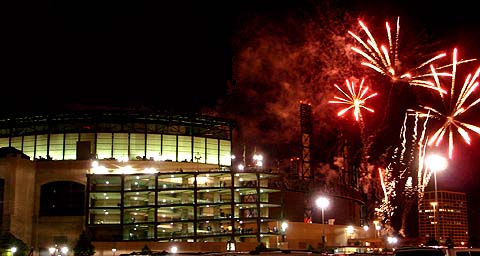 |
Ugh.
Not only was that the reaction of many ballpark enthusiasts to “New” Comiskey Park (especially when compared to other new parks that opened in the 1990s), that was also our feeling when it was announced in 2001 that the stadium’s name was changing to U.S. Cellular Field.
| Ballpark Stats |
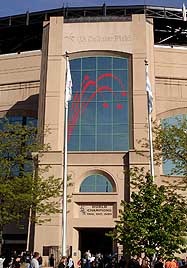 |
| First game: a 16-0 pummeling by Detroit on April 18, 1991 |
| Capacity: 40,615 following the removal of 6,600 seats in 2004 |
| Architect: HOK |
| Price: $137 million (remember, this was 1991) |
| Home dugout: 3B side |
| Field points: Southeast |
| Playing surface: grass |
| Betcha didn’t know: The infield dirt — all 550 tons of it — was transplanted from “old” Comiskey Park |
Little did we know that the latter was going to help fix the former.
What?
Here’s what I mean. Truly, when the White Sox’ new facility was measured against Camden Yards, Coors Field, The Ballpark In Arlington, etc., it was found to be lacking. Personally, the one thought that brought me comfort was the knowledge that it would produce no offspring because it was far too sterile! However, when U.S. Cellular, a cell-phone company with over 5 million customers, agreed to pay $68 million to put its name on the White Sox’ stadium for 23 years, it provided a revenue stream for the team that permitted them to commit to major improvements in the stadium. The team had listened to the negative comments about the monstrously tall-and-steep upper deck and the vacuous spaces in the outfield, and they pledged to fix them.
They did. Now that the five-stage renovations are pretty much completed (stage five, which involves changing the old blue seats for ones that are ballpark-green, is still going on as of this writing), I am prepared to change my rating of this ballpark … and I could never bring myself to call this facility a “ballpark” until now. Without a doubt, a fresh look at this re-born entertainment destination is quite warranted.
Because the changes are so significant, this ballpark review will treat U.S. Cellular Field similarly to the way we examine brand-new ballparks, right down to using the four-part format of scrutinizing the park’s setting, exterior, design and “the essentials” (i.e., the game-day experience and facilities).
But first, let me list ten reasons (that will be touched upon throughout the review) why you should visit U.S. Cellular Field, especially if you haven’t attended a game here in the past two years:
- The re-done upper deck
- The re-invented outfield concourse
- The FUNdamentals kids area
- The tailgating
- Nancy Faust
- Visiting where “old” Comiskey Park was located
- The extensive mural of Chicago baseball history that adorns the walls of the upper deck’s concourse
- The gentrification of the surrounding neighborhoods
- The pinwheels on top of the scoreboard
- Experiencing what it feels like for a sports franchise to revel in winning a World Series for the first time in 87 years.
The Setting
Well, the south side of Chicago is the baddest part of town.
For decades, the neighborhoods south of Chicago’s downtown were fairly dangerous. Songs such as “Bad, Bad Leroy Brown” depicted this area as someplace you wouldn’t want to visit. The first time I attended a White Sox game in 1990, I found myself thrust into this neighborhood upon leaving the parking lot next to the stadium, and I know I felt unsafe traveling those dark streets.
This has changed.
The word “gentrification” leaps to mind when you drive through this area now. The part of the southside that is just to the west of the railroad tracks that run along the western edge of U.S. Cellular Field’s parking lots is being revitalized. I saw several construction projects where old buildings were being converted into trendy condos (one sign boasts “condos from the mid $200’s” while another announced that its units were going for $300,000 and up).
Condos costing that much money in this neighborhood? Yes! The streets seem safer, cleaner and more heavily patrolled by police than ever before. Therefore, plan on arriving early for a Sox game and exploring the area. You’ll find a number of pubs, eateries and stores worth a visit. The Grandstand at 600 West 35th Street (about four blocks west of the stadium’s north parking lots) is an immense store crammed with every manner of White Sox souvenirs and apparel.
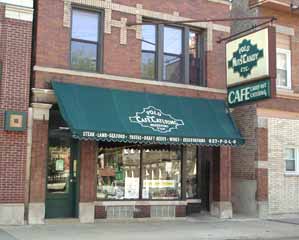 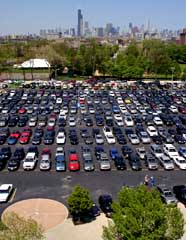 |
Eating places and watering holes with a lot of local (read that White Sox) flavor include Catcher’s Inn at 901 West 35th Street and Polo’s Cafe (see photo above) at 3322 Morgan Street. The latter features Angus steaks and seafood, and the decor provides a little bit of a Chicago history lesson.
The exact site of the Cell is directly next door to plot of ground that once held the original Comiskey Park, constructed in 1910. It’s used for parking now, but the location of home plate can be easily found in Parking Lot B, near 35th Street. You see it in the lower-left corner of the righthand photo above.
This photo also points out something else about the setting of the Cell. This shot was taken from the pedestrian ramps next to the stadium, not from within the ballpark itself. Because the footprint of the stadium causes it to “face” southeast (i.e., if you draw an arrow from homeplate through second base toward center field, it would point to the southeast), you cannot see the beautiful downtown skyline from within the stadium — or even from the concourses. This is a shame, because if the stadium had faced northeast (like the Baseball Rule Book recommends) or north, the skyline would’ve been in view.
U.S. Cellular Field is located next to the Dan Ryan Expressway, which runs north-south between downtown Chicago and the Indiana state line. During the 2006 season, this highway is undergoing considerable construction, so you might want to avoid it and approach the stadium through the neighborhoods west of the park.
The famous Chicago “L” also makes it convenient to take the train to the ballpark. Both the Red and Green Lines have a stop at 35th Street, right next to the Cell.
The Exterior
Even after the renovations, no one is going to mistake the exterior of U.S. Cellular Field for the Taj Mahal. In fact, the way the pedestrian ramps are placed just to the outside the park, most of the exterior is obscured.
While this is not a great tragedy, it is disappointing that some of the nice touches aren’t plainly noticeable. For one thing, the exterior features columns and arches that resemble those on old Comiskey Park. You can also see the new roof from the parking lots of the Cell, and this definitely makes it look much more like a ballpark!
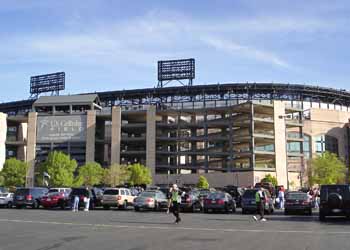 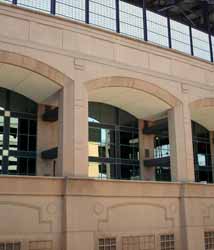 |
The only entryway that looks like it belongs at a classic ballpark is the narrow one directly behind home plate. You can see it in the photo in the Ballpark Stats box toward the top of this page.
The Design
I was lucky enough to attend a Sox game during old Comiskey’s last season in 1990. You couldn’t miss the mammoth structure of the new stadium towering over the two-decked 80-year-old ballpark. And it was the incredible height of “new” Comiskey that so many fans disliked.
The upper deck of the new facility was so tall and so steep that it seemed to me that it would be better used as a ski jump than in a ballpark.
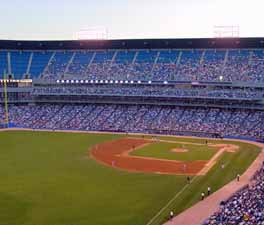 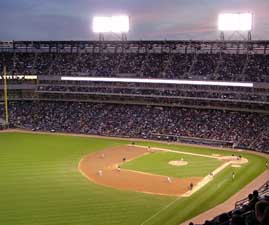 |
Examine the “before and after” pictures above. The shot on the left was from 2003, while the right is from 2006. The renovation of the upper deck involved removing the top eight rows of seats and constructing a completely new roof. This is an incredibly positive change for several reasons. First, the intimacy of the entire park is increased significantly. Second, the new roof is an enormous improvement over the sterile concrete overhang that it replaced. Third, even though the “pitch” of the remaining rows didn’t change, it just doesn’t seem as steep as it used to.
The outfield concourse (see below) also received a major upgrade through this renovation process. In dead center field, a terraced structure was added that created a “Fan Deck” where you can watch the game at countertops, which are great for your food and drink. The vantage point reminds me of the Rockpile seats at Denver’s Coors Field, only closer to the action. The front of this structure that faces the field is covered with dark-green vegetation that acts as the “batters eye.” Very attractive!
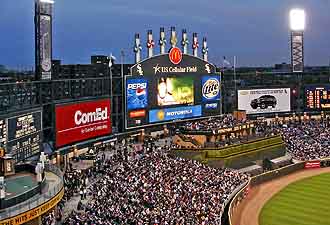  |
This whole outfield concourse acts as a “destination” in and of itself. Music, statues, games, eateries — even a shower stall for those blistering summer days — create an exciting, bustling entertainment spot, much like the outfield at the Phillies’ Citizens Bank Park.
As you walk toward the left-field foul pole from the Fan Deck, you run into another one of the brilliant features that the renovation created. The FUNdamentals area is a play area for kids. However, it’s not made up of arcade games. Instead, it is a three-level zone where youngsters can sharpen their batting, throwing, fielding and baserunning skills. In this respect, it outdoes the similar spots in the parks of Arlington, San Francisco, Atlanta and Kansas City.